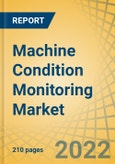The global machine condition monitoring market is expected to reach $5.2 billion by 2029, growing at a CAGR of 7.3% during the forecast period of 2022-2029.
The growth of this market is attributed to the increasing awareness about the importance of predictive maintenance techniques by industry players and the rising adoption of Industry 4.0 technologies. In addition, the rising focus on reducing human intervention in predictive maintenance is expected to offer significant growth opportunities for the growth of this market. However, the shortage of technical experts restrains the growth of this market to a certain extent.
Based on component, the market is segmented into hardware, software, and services. In 2022, the software segment is expected to account for the largest share of the overall machine condition monitoring market. Increasing machine condition monitoring software use to reduce downtime, increase efficiency and boost productivity is expected to drive market growth. Also, this segment is projected to grow at the highest CAGR during the forecast period.
Based on deployment mode, the market is segmented into on-premise and cloud-based deployment. In 2022, the cloud-based deployment segment is expected to account for the larger share of the overall machine condition monitoring market. The growth of this segment is attributed to the growing preference for the software as a service (SaaS) model by industry players due to potential cost savings and the ability to remotely monitor industrial equipment offered by cloud-based deployment. Also, this segment is projected to grow at the highest CAGR during the forecast period.
Based on monitoring technique, the market is segmented into vibration monitoring, corrosion monitoring, thermography, oil analysis, ultrasound monitoring, and other monitoring techniques such as motor current analysis and pressure monitoring. In 2022, the vibration monitoring segment is expected to account for the largest share of the overall machine condition monitoring market. The growth of the segment is attributed to the rising concern related to product safety and functionality and the increasing adoption of vibration techniques in the industrial sector. However, the corrosion monitoring segment is expected to grow at the highest CAGR during the forecast period.
Based on end-use industry, the market is segmented into manufacturing, healthcare, energy & utilities, aerospace, telecom, agriculture, oil & gas, transportation & logistics, and other end-use industries. In 2022, the manufacturing segment is expected to account for the largest share of the overall machine condition monitoring market. Thus, the increasing adoption of digital technologies, such as automation, data analytics, and industrial IoT in manufacturing plants, is driving the market growth.
Based on geography, the market is broadly segmented into North America, Europe, Asia-Pacific, Latin America, and the Middle East and Africa. In 2022, Asia-Pacific is expected to account for the largest share of the global machine condition monitoring market and is expected to grow at the highest CAGR during the forecast period. Factors such as rising demand for automation, the presence of high-production countries such as China and Japan, and exerting efforts by companies to launch machine condition monitoring components are driving the market growth in the region.
The key players operating in the global machine condition monitoring market are General Electric Company (U.S.), AB SKF (Sweden), Wilcoxon Sensing Technologies (U.S.), Emerson Electric Co. (U.S.), ALS Limited (Australia), Honeywell International Inc. (U.S.), Parker-Hannifin Corporation (U.S.), Rockwell Automation, Inc. (U.S.), ifm electronic gmbh (Germany), Schaeffler AG (Germany), Baker Hughes Company (U.S.), Analog Devices, Inc. (U.S.), Fluke Corporation (U.S.), Meggitt PLC (U.K.), and National Instruments Corporation (U.S.).
Key questions answered in the report:
- Which are the high-growth market segments in terms of component, deployment mode, monitoring process, monitoring technique, end-use industry, and countries?
- What is the historical market for machine condition monitoring across the globe?
- What are the market forecasts and estimates from 2022-2029?
- What are the major drivers, restraints, and opportunities in the global machine condition monitoring market?
- Who are the major players in the global machine condition monitoring market, and what shares of the market do they hold?
- Who are the major players in various countries, and what shares of the market do they hold?
- How is the competitive landscape?
- What are the recent developments in the global machine condition monitoring market?
- What are the different strategies adopted by the major players in the global machine condition monitoring market?
- What are the geographical trends and high-growth countries?
- Who are the local emerging players in the global machine condition monitoring market and how do they compete with the other players?
Scope of the Report:
Machine Condition Monitoring Market, by Component
- Hardware
- Sensors
- Analyzers
- Other hardware
- Software
- Services
Machine Condition Monitoring Market, by Deployment Mode
- On-premise deployment
- Cloud-based deployment
Machine Condition Monitoring Market, by Monitoring Process
- Online Monitoring
- Portable Monitoring
Machine Condition Monitoring Market, by Monitoring Technique
- Vibration Monitoring
- Corrosion Monitoring
- Thermography
- Oil Analysis
- Ultrasound Monitoring
- Other Monitoring Techniques
Machine Condition Monitoring Market, by End-use Industry
- Manufacturing
- Healthcare
- Energy & Utilities
- Aerospace
- Telecom
- Agriculture
- Oil & Gas
- Transportation & Logistics
- Other End-use Industries
Machine Condition Monitoring Market, by Geography
- North America
- U.S.
- Canada
- Europe
- U.K.
- Germany
- France
- Italy
- Spain
- Rest of Europe
- Asia-Pacific
- China
- India
- Japan
- South Korea
- Singapore
- Rest of Asia-Pacific
- Latin America
- Middle East & Africa
Table of Contents
Companies Mentioned
- General Electric Company (U.S.)
- AB SKF (Sweden)
- Wilcoxon Sensing Technologies (U.S.)
- Emerson Electric Co. (U.S.)
- ALS Limited (Australia)
- Honeywell International Inc. (U.S.)
- Parker-Hannifin Corporation (U.S.)
- Rockwell Automation Inc. (U.S.)
- ifm electronic gmbh (Germany)
- Schaeffler AG (Germany)
- Baker Hughes Company (U.S.)
- Analog Devices Inc. (U.S.)
- Fluke Corporation (U.S.)
- Meggitt PLC (U.K.)
- National Instruments Corporation (U.S.).








